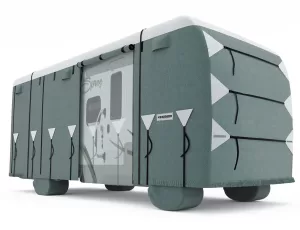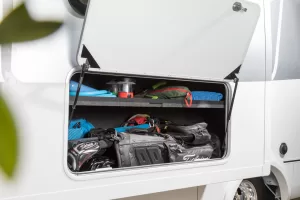Newell P50
Newell Coach Corporation designs, engineers, and builds ultra-luxury motorhomes from the ground up: one-of-a-kind models filled with custom features.
By Mark Quasius, F333630
December 2022
When discussing the “ultimate” motor coach, Newell is a name that immediately comes to mind. Newell Coach Corporation is known for innovative engineering, extreme luxury, and cutting-edge technology and features. Every Newell motorhome is custom-built; the majority are constructed for individual clients. To develop a plan, customers meet with Newell’s design team over the course of several days. Every detail needs to be worked out, from the basic floor plan to furniture, cabinet selections, and fabrics. The entertainment system, appliances, and fixtures also must be selected, as well as the final custom paint scheme. No two coaches will be alike, although Newell does have basic floor plans that a buyer can select from and modify as desired.
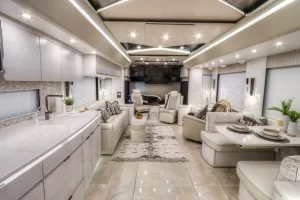
Each client collaborates with the Newell design team to create a customized coach, as shown in the featured unit’s living area.
Rather than use a standard chassis from another manufacturer, Newell constructs its own foundation to fit the chosen design and floor plan. This results in a chassis that maximizes basement storage space and optimizes the holding tank locations for the floor plan.
This article focuses on one particular unit, a P50, that I had the opportunity to inspect and, as such, does not cover all the possibilities. However, Newell incorporates its core values and practices into its entire line of luxury motorhomes, so this review should serve as an accurate barometer for anyone considering a coach from the company.
The Build
To achieve the level of quality and detail that customers expect, each Newell requires a bit of time to create. Once the design plan has been completed, it will take about 5½ months and thousands of man-hours for skilled technicians to build a Newell coach. The process begins in the frame shop, where a custom frame is welded. All wiring is run through a wire chase for durability and ease of access. The axles, suspension, and drivetrain are installed as the coach moves to the floor construction area.
The unit then receives a floor that is 7 inches thick and is composed of high-density structural foam sandwiched between layers of ½-inch plywood. Slideouts are set in place; their mechanisms and their motorized drop-down floors are installed and tested.
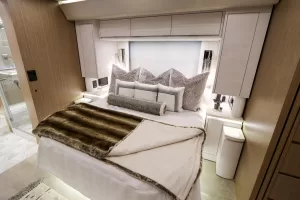
In the P50 toured for this article, the bedroom makes an elegant refuge with designer fabrics, cabinetry, and lighting.
Traditional motorhome construction involves prefabricated wall assemblies, which are set on top of the floor. Newell builds its coach walls and roof structure by creating an aluminum skeleton, similar to residential stick framing. This forms a continuous monocoque structure that distributes stresses evenly across the entire chassis. This rigid structure eliminates flexing of the chassis, resulting in a smooth and stable ride. Aluminum skin is applied over the skeleton, and every seam is sealed. A water test is performed to ensure the structure is leakproof. Electrical wiring is strung within the walls and ceiling.
High R-value foam insulation is sprayed inside the coach and shaved off to create a smooth, flat surface before being capped off with plywood. Baltek mat-reinforced fiberglass front and rear caps are installed; this material is said to be stronger than the usual fiberglass created with blown fiber.
Next the coach receives its interior partition walls and any additional wiring and plumbing. To prevent freezing, all plumbing is run within the thick floor rather than beneath it in the basement areas. Each drain line is set at the exact pitch for proper drainage, and the floor is then reinsulated with spray foam around the drain lines.
Over the next few months, wall coverings, the finished floor, appliances, and other furnishings are added to the interior. Final wiring and connecting the coach’s advanced systems is completed, while a pair of Outback inverters is installed and the extensive multiplex wiring system is connected and programmed.
The next step is to head to the paint shop, where Sikkens paint is applied to create the color scheme chosen by the owner. Once the color has been applied, seven coats of clear polyurethane are added, interspersed with various steps of cut and buff polishing to achieve that deep under-glass look for which Newell motorhomes are known.
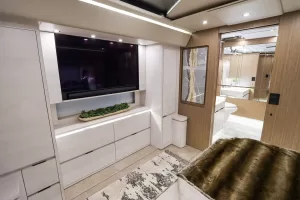
A large LED TV is positioned opposite the king-size bed.
After undergoing 100-plus hours of work in the paint shop, the coach moves to final fit and finish so that mirrors, awnings, and other external accessories or trim can be added. A series of five road tests is completed to calibrate the engine’s electronic control module, the transmission control module, and the computer-assisted suspension. The coach is thoroughly inspected, and any items that need to be addressed are written up on a trip report. A smoke test also is performed to ensure the absence of air leaks, plus two more water tests.
Once the coach is ready, it is presented to Newell management for a final executive review before being deemed complete. The review by engineering and management personnel is just the final of numerous quality control inspections that take place throughout the 5½-month build time.
Features
While every Newell is distinct, a number of features are common to all vehicles produced by the company. Each custom-built frame is equipped with a 605-horsepower Cummins X15 diesel engine. A ZF StabilRide air suspension utilizes large outboard air bags to minimize roll and is fitted with computer-controlled electronic shocks that react within 10 milliseconds to vary the shock absorber dampening as needed. The suspension can be adjusted at the instrument panel, altering the ride and handling between “comfort” and “sport” to suit a driver’s personal taste.
Newell coaches also are equipped with EasiSteer electronic-assist steering to lessen the effects of crosswinds and provide a comfortable drive. The steerable tag axle is an active-steer unit, unlike the passive-steer units used on most Type A motorhomes; on tight turns, it automatically engages to improve the turning radius. Newell’s own Intrepid 2.0 coach management system (CMS) utilizes a digital glass dash instrument panel that can be customized with a choice of numerous analog or digital gauge layouts. The Intrepid CMS also provides extensive diagnostic functions.
Newell departs from the typical practice of mounting the generator in the front cap on slideout rails, as in Type A motorhomes, or in a rear location, as seen on bus conversions. Technicians place a 20-kilowatt diesel-powered generator in the coach’s front cap, but the fiberglass portion lifts up to reveal a soundproof enclosure with a pair of swing-out insulated steel doors. Most generators route intake air and exhaust it through the radiator, which requires a large hole in the enclosure that allows engine noise to escape. Instead, Newell seals the generator enclosure and relocates the radiator to a midships basement compartment, adding a large squirrel cage blower above it to push hot air from the radiator to the ground beneath. Coolant from the generator’s engine is pumped back to the radiator.
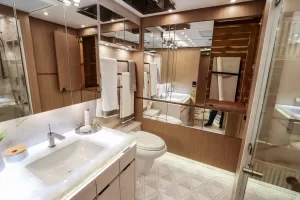
The rear bath in the featured unit offers plentiful storage space, including a mirrored wardrobe.
Coach interior heating, as well as domestic hot water needs, are handled by a large Aqua-Hot 675D hydronic heating system. The diesel burner is augmented by a pair of electric heating elements and can provide unlimited hot water. Exhaust from both the generator and the hydronic system’s diesel burner exit out the rear of the coach rather than into your neighbor’s patio area. Electric in-floor heating also is provided to warm the polished porcelain tile floor in cool weather.
Two air compressors keep the air system pressurized at all times to provide automatic leveling and to power various pneumatic doors in the motorhome. Four ducted air conditioners cool the coach on hot days.
Newell’s flush-floor slideouts deserve particular mention. They move quietly and smoothly via side mechanisms that are hidden beneath enclosures equipped with drop-down covers. When a slideout reaches full extension, a riser panel extends upward, filling the gap where the slideout floor had been. When the process is reversed, the floor panel drops back down into the floor, and the retracting slideout returns to its original place as the side arms fold down. In addition, pneumatic seals inflate to ensure an airtight seal and a quiet drive. The placement of the mechanisms increases aisle space with the slideouts retracted for travel.
Naturally, a coach of this caliber is filled with tons of accessories and electronics that require power. In addition to the 20-kw generator, a 50-amp shore power supply, a 90-amp surge-protected transfer switch, and the two 2,800-watt Outback true sine wave inverters are integrated into a system that monitors power usage and can automatically control the loads or start the generator as needed. A pressure washer makes quick work of cleaning the exterior and removing bugs, while a deionizer can deliver spot-free rinse water with the flick of a switch. Both the fresh-water hose reel and the sewer hose are power-retractable.
The fresh-water tank holds 143 gallons; the holding tank is matched to the size of the fresh-water tank. The 205-gallon stainless-steel fuel tank can be filled from either side of the coach; a 21-gallon DEF tank fill is located on the driver’s side.
The 4K LED TV screens are integrated into a multiplexed central entertainment center system with studio-grade components that incorporate security cameras. Throughout the coach, touch-screen panels interface with the Intrepid CMS to allow access to climate controls, the entertainment system, shades, lighting, and other systems. An iPad wireless tablet or smartphone app also can be used to control these systems.
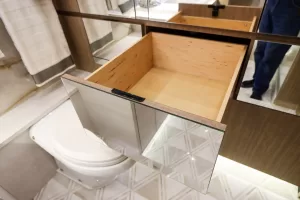
One of the deep bathroom drawers in the review unit.
Several exterior features illustrate Newell’s cutting-edge design style. The front cap sports LED headlamp accent lighting; the latest style features an attractive black glass front cap that can be backlit to display the Newell logo. The glass front also makes for easy cleanup of bug splatter and eliminates paint chips. A redesigned rear cap features attractive new styling as well. Integrated patio awnings, overhead side-view mirrors, and subtle exhaust diffusers all combine for an eye-popping appearance.
But a Newell motorhome boasts attributes besides beauty, durability, and a custom-built chassis. The coaches also are extremely functional. For example, everywhere you look, you’ll find storage areas. Cabinets, storage nooks, and huge wardrobe drawers ensure you won’t have any problem finding room for your cargo.
Road Test And Review
Driving the Newell P50 is a different experience. Seated in the heated and cooled pilot’s seat, you’ll be surrounded by tons of useful information. The digital dash is user-configurable to bring up the information you want to see, in the format you prefer. Three monitors interface with the motorhome’s various cameras. Left of the dash, a Garmin GPS unit is secured by a magnetic dock so it can be removed for creating routes and snapped back into place for travel. A second GPS unit is found on the right side for the copilot to use.
Immediately right of the instrument panel, a 15-inch screen provides access to climate and leveling controls, camera arrangements, power mirrors, and other functions. To its right is another touch-screen panel that interfaces with the Intrepid 2.0 CMS.
I was impressed by the driver’s aids. The EasiSteer steering assist made this large coach effortless to handle and turned crosswinds into a non-event; an adjustable control on the instrument panel allows the driver to tailor the assist to his or her personal preference. The ZF StabilRide active suspension reacts instantaneously to changes; it provided excellent control with-out sacrificing a smooth ride. Electronically controlled shock absorbers react within 10 milliseconds to further enhance handling. An automatic ride-height mode can lower the coach a few inches when traveling at freeway speeds, reducing air pressure in the suspension system and delivering a smoother ride; it returns the coach to normal ride height at slow speeds.
Based on the 56,643-pound average wet weight (with driver) and a 63,300-pound gross vehicle weight rating (GVWR), the coach I inspected had 6,657 pounds of cargo carrying capacity (CCC). The 25,000-pound-rated Class 5 hitch and 88,300-pound gross combination weight rating (GCWR) provide plenty of towing capacity.
With 605 horsepower, I had no problem getting the coach up to speed. The 1,950 pound-feet of torque in the big 15-liter Cummins ISX let the coach move effortlessly at low rpm without having to downshift for most grades. When maneuvering in tight spots, the active tag axle allowed the coach to turn nice and sharp, making it feel much shorter than its 45 feet.
Wind noise was virtually nonexistent in the aerodynamic P50. The thick insulated floor, flush-mounted slideouts with exacting tolerances, integrated awnings, and slideouts and entry doors with inflatable pneumatic seals all contributed to an extremely quiet ride.
The Newell P50 truly can be called an ultimate luxury motor coach, with innovative technology, superb attention to detail, and creative styling by Porsche Design. Priced between $2.4 million and $2.7 million, Newell motorhomes are for a select group of customers who seek quality, style, and value at a whole different level from other coaches.
Newell Coach Corporation
3900 N. Main St.
Miami, OK 74354
(918) 542-3344
www.newellcoach.com
The post Newell P50 appeared first on Family RVing Magazine.


